Climate Change Impacts on Future Wheat (Triticum aestivum) Yield, Growth Periods and Irrigation Requirements: A SALTMED Model Simulations Analysis
Abstract
:1. Introduction
2. Material and Methods
2.1. Field Experiment and Sampling
2.2. Crop Data Collection and Analysis
2.3. Climate and Data Downscaling
2.4. SALTMED Model Applications
3. Results
3.1. Soil Fertility of the Experiment Sites
3.2. Wheat Response under Different Treatments
3.3. Projected Future Climate Data for Model Run
3.4. SALTMED Model Run
3.5. Scenario Simulation
3.5.1. Impact on Crop Growth Period
3.5.2. Impact on Crop Yield and Productivity
3.5.3. Simulations of Hypothetical Scenarios
4. Discussion
5. Conclusions
Author Contributions
Funding
Data Availability Statement
Acknowledgments
Conflicts of Interest
References
- World Bank. The World Bank. Annual Report. 2020; World Bank: Washington, DC, USA, 2020; ISBN 978-1-4648-1619-2. [Google Scholar]
- GOV. Economic Survey of Pakistan 2021-22; Economic Adviser’s Wing, Finance Division, Government of Pakistan: Islamabad, Pakistan, 2022. [Google Scholar]
- Kiprutto, N.; Rotich, L.K.; Riungu, G.K. Agriculture, Climate Change and Food Security. OAlib 2015, 2, 1–7. [Google Scholar] [CrossRef]
- Dhakal, R.S.; Syme, G.; Andre, E.; Sabato, C. Sustainable Water Management for Urban Agriculture, Gardens and Public Open Space Irrigation: A Case Study in Perth. Agric. Sci. 2015, 6, 676–685. [Google Scholar] [CrossRef]
- Pastor, A.V.; Palazzo, A.; Havlik, P.; Biemans, H.; Wada, Y.; Obersteiner, M.; Kabat, P.; Ludwig, F. The Global Nexus of Food–Trade–Water Sustaining Environmental Flows by 2050. Nat. Sustain. 2019, 2, 499–507. [Google Scholar] [CrossRef]
- Makate, C.; Makate, M.; Mango, N.; Siziba, S. Increasing Resilience of Smallholder Farmers to Climate Change through Multiple Adoption of Proven Climate-Smart Agriculture Innovations. Lessons from Southern Africa. J. Environ. Manag. 2019, 231, 858–868. [Google Scholar] [CrossRef]
- Ahanger, M.; Qin, C.; Begum, N.; Maodong, Q.; Dong, X.; El-Esawi, M.A.; El-Sheikh, M.; Alatar, A.; Zhang, L. Nitrogen Availability Prevents Oxidative Effects of Salinity on Wheat Growth and Photosynthesis by Up-Regulating the Antioxidants and Osmolytes Metabolism, and Secondary Metabolite Accumulation. BMC Plant Biol. 2019, 19, 479. [Google Scholar] [CrossRef]
- Wiebe, K.; Robinson, S.; Cattaneo, A. Climate Change, Agriculture and Food Security. In Sustainable Food and Agriculture; Elsevier: Amsterdam, The Netherlands, 2019; pp. 55–74. [Google Scholar]
- World Bank. World Bank Annual Report 2023: A New Era in Development (English); World Bank: Washington, DC, USA, 2023. [Google Scholar]
- Hellin, J.; Fisher, E. Climate-Smart Agriculture and Non-Agricultural Livelihood Transformation. Climate 2019, 7, 48. [Google Scholar] [CrossRef]
- Rahman, M.H.; Ahmad, A.; Wang, X.; Wajid, A.; Nasim, W.; Hussain, M.; Ahmad, B.; Ahmad, I.; Ali, Z.; Ishaque, W.; et al. Multi-Model Projections of Future Climate and Climate Change Impacts Uncertainty Assessment for Cotton Production in Pakistan. Agric. For. Meteorol. 2018, 253–254, 94–113. [Google Scholar] [CrossRef]
- Chauhdary, J.N.; Bakhsh, A.; Engel, B.A.; Ragab, R. Improving Corn Production by Adopting Efficient Fertigation Practices: Experimental and Modeling Approach. Agric. Water Manag. 2019, 221, 449–461. [Google Scholar] [CrossRef]
- Ragab, R. SALTMED Publications in Irrigation and Drainage, 1st ed.; Schultz, B., Ed.; Wiley Online Library: Hoboken, NJ, USA, 2020. [Google Scholar]
- Hirich, A.; Fatnassi, H.; Ragab, R.; Choukr-Allah, R. Prediction of Climate Change Impact on Corn Grown in the South of Morocco Using the Saltmed Model. Irrig. Drain. 2016, 65, 9–18. [Google Scholar] [CrossRef]
- Pakpedia Gojra Weather Statistics. Available online: https://www.pakpedia.pk/gojra/#:~:text=Throughout%20the%20year%2C%20the%20temperature%20may%20vary%20from,resulting%20in%20average%20annual%20rainfall%20of%2068.58%20mm (accessed on 13 February 2024).
- WWO. Toba Tek Singh Annual Weather Averages. Available online: https://www.worldweatheronline.com/toba-tek-singh-weather-averages/punjab/pk.aspx (accessed on 13 February 2024).
- Taylor, K.; Ronald, S.; Meehl, G. An Overview of CMIP5 and the Experiment Design. Bull. Am. Meteorol. Soc. 2011, 93, 485–498. [Google Scholar] [CrossRef]
- Haider, H.; Zaman, M.; Liu, S.; Saifullah, M.; Usman, M.; Chauhdary, J.N.; Anjum, M.N.; Waseem, M. Appraisal of Climate Change and Its Impact on Water Resources of Pakistan: A Case Study of Mangla Watershed. Atmosphere 2020, 11, 1071. [Google Scholar] [CrossRef]
- Chauhdary, J.N.; Li, H.; Akbar, N.; Javaid, M.; Rizwan, M.; Akhlaq, M. Evaluating Corn Production under Different Plant Spacings through Integrated Modeling Approach and Simulating Its Future Response under Climate Change Scenarios. Agric. Water Manag. 2024, 293, 108691. [Google Scholar] [CrossRef]
- Jones, C.; Robertson, E.; Arora, V.; Friedlingstein, P.; Shevliakova, E.; Bopp, L.; Brovkin, V.; Hajima, T.; Kato, E.; Kawamiya, M.; et al. Twenty-First-Century Compatible CO2 Emissions and Airborne Fraction Simulated by CMIP5 Earth System Models under Four Representative Concentration Pathways. J. Clim. 2013, 26, 4398–4413. [Google Scholar] [CrossRef]
- Tschöke, G.V.; Kruk, N.S.; de Queiroz, P.I.B.; Chou, S.C.; de Sousa Junior, W.C. Comparison of Two Bias Correction Methods for Precipitation Simulated with a Regional Climate Model. Theor. Appl. Climatol. 2017, 127, 841–852. [Google Scholar] [CrossRef]
- Ragab, R. Integrated Management Tool for Water, Crop, Soil and N-Fertilizers: The Saltmed Model. Irrig. Drain. 2015, 64, 1–12. [Google Scholar] [CrossRef]
- Soothar, R.K.; Zhang, W.; Zhang, Y.; Tankari, M.; Mirjat, U.; Wang, Y. Evaluating the Performance of SALTMED Model under Alternate Irrigation Using Saline and Fresh Water Strategies to Winter Wheat in the North China Plain. Environ. Sci. Pollut. Res. 2019, 26, 34499–34509. [Google Scholar] [CrossRef]
- French, R.J. Nutrient Management Guidelines for Wheat in Mediterranean-Type Environments. Aust. J. Agric. Res. 1998, 39, 631–642. [Google Scholar]
- Shaheen, N.; Jahandad, A.; Goheer, M.A.; Ahmad, Q.A. Future Changes in Growing Degree Days of Wheat Crop in Pakistan as Simulated in CORDEX South Asia Experiments. APN Sci. Bull. 2020, 10, 1–12. [Google Scholar] [CrossRef]
- Adeel, A.; Adnan, M. Impact of Full vs. Deficit Irrigations on Various Phenological Stages of Wheat. Int. J. Agron. Agric. Res. 2018, 13, 55–62. [Google Scholar]
- Zamani, A.; Emam, Y.; Edalat, M. Response of Bread Wheat Cultivars to Terminal Water Stress and Cytokinin Application from a Grain Phenotyping Perspective. Agronomy 2024, 14, 182. [Google Scholar] [CrossRef]
- Ali, S.; Xu, Y.; Ma, X.; Ahmad, I.; Kamran, M.; Dong, Z.; Cai, T.; Jia, Q.; Ren, X.; Zhang, P.; et al. Planting Patterns and Deficit Irrigation Strategies to Improve Wheat Production and Water Use Efficiency under Simulated Rainfall Conditions. Front. Plant Sci. 2017, 8, 1408. [Google Scholar] [CrossRef] [PubMed]
- Lal, R. Enhancing Crop Yields in the Developing Countries through Restoration of the Soil Organic Carbon Pool in Agricultural Lands. Land. Degrad. Dev. 2006, 17, 197–209. [Google Scholar] [CrossRef]
- Marschner, P.; Rengel, Z. Nutrient Availability in Soils. In Marschner’s Mineral Nutrition of Higher Plants; Elsevier: Amsterdam, The Netherlands, 2012; pp. 315–330. [Google Scholar]
- Smith, S.E.; Read, D. Mycorrhizas in Agriculture, Horticulture and Forestry. In Mycorrhizal Symbiosis; Elsevier: Amsterdam, The Netherlands, 2008; pp. 611–625. [Google Scholar]
- Chauhdary, J.N. Modeling Effects of Different Irrigation and Fertigation Strategies on Maize (Zea mays) Response and Salinity Buildup in Root Zone under Drip Irrigation. Ph.D. Dissertation, University of Agriculture, Faisalabad, Pakistan, 2018. [Google Scholar]
- Roy, S.; Chowdhury, N. Salt Stress in Plants and Amelioration Strategies: A Critical Review. In Abiotic Stress in Plants; IntechOpen: London, UK, 2021. [Google Scholar]
- Shi, H.; Hou, L.; Xu, X.; Zhu, Y.; Zhai, B.; Liu, Z. Effects of Different Rates of Nitrogen Fertilizer on Apple Yield, Fruit Quality, and Dynamics of Soil Moisture and Nitrate in Soil of Rainfed Apple Orchards on the Loess Plateau, China. Eur. J. Agron. 2023, 150, 126950. [Google Scholar] [CrossRef]
- Yu, B.-G.; Chen, X.-X.; Zhou, C.-X.; Ding, T.-B.; Wang, Z.-H.; Zou, C.-Q. Nutritional Composition of Maize Grain Associated with Phosphorus and Zinc Fertilization. J. Food Compos. Anal. 2022, 114, 104775. [Google Scholar] [CrossRef]
- Li, S.X.; Wang, Z.H.; Hu, T.T.; Gao, Y.J.; Stewart, B.A. Chapter 3 Nitrogen in Dryland Soils of China and Its Management. In Advances in Agronomy; Elsevier: Amsterdam, The Netherlands, 2009; pp. 123–181. [Google Scholar]
- Wu, W.; Wang, Y.; Wang, L.; Xu, H.; Zörb, C.; Geilfus, C.-M.; Xue, C.; Sun, Z.; Ma, W. Booting Stage Is the Key Timing for Split Nitrogen Application in Improving Grain Yield and Quality of Wheat—A Global Meta-Analysis. Field Crops Res. 2022, 287, 108665. [Google Scholar] [CrossRef]
- Sharma, A.R.; Behera, U.K. Response of Wheat (Tritucum aestivum) to Nitrogen Fertilization under Varying Tillage and Crop Establishment Practices in Greengram–Wheat Cropping System. Exp. Agric. 2016, 52, 605–616. [Google Scholar] [CrossRef]
- Abebe, B. Effect of the Time and Rate of N-Fertilizer Application on Growth and Yield of Wheat (Triticum aestivum L.) at Gamo-Gofa Zone, Southern Ethiopia. J. Nat. Sci. Res. 2016, 6, 111–122. [Google Scholar]
- Feleke, H.G.; Savage, M.; Tesfaye, K. Calibration and Validation of APSIM–Maize, DSSAT CERES–Maize and AquaCrop Models for Ethiopian Tropical Environments. S. Afr. J. Plant Soil 2021, 38, 36–51. [Google Scholar] [CrossRef]
- Ren, X.; Sun, D.; Wang, Q. Modeling the Effects of Plant Density on Maize Productivity and Water Balance in the Loess Plateau of China. Agric. Water Manag. 2016, 171, 40–48. [Google Scholar] [CrossRef]
- Daliakopoulos, I.N.; Pappa, P.; Grillakis, M.G.; Varouchakis, E.A.; Tsanis, I.K. Modeling Soil Salinity in Greenhouse Cultivations under a Changing Climate with SALTMED: Model Modification and Application in Timpaki, Crete. Soil. Sci. 2016, 181, 241–251. [Google Scholar] [CrossRef]
- Chauhdary, J.N.; Bakhsh, A.; Ragab, R.; Khaliq, A.; Engel, B.A.; Rizwan, M.; Shahid, M.A.; Nawaz, Q. Modeling Corn Growth and Root Zone Salinity Dynamics to Improve Irrigation and Fertigation Management under Semi-Arid Conditions. Agric. Water Manag. 2020, 230, 105952. [Google Scholar] [CrossRef]
- Gaydon, D.S.; Balwinder-Singh; Wang, E.; Poulton, P.L.; Ahmad, B.; Ahmed, F.; Akhter, S.; Ali, I.; Amarasingha, R.; Chaki, A.K.; et al. Evaluation of the APSIM Model in Cropping Systems of Asia. Field Crops Res. 2017, 204, 52–75. [Google Scholar] [CrossRef]
- Hanson, C.E.; Palutikof, J.P.; Livermore, M.T.J.; Barring, L.; Bindi, M.; Corte-Real, J.; Durao, R.; Giannakopoulos, C.; Good, P.; Holt, T.; et al. Modelling the Impact of Climate Extremes: An Overview of the MICE Project. Clim. Chang. 2007, 81, 163–177. [Google Scholar] [CrossRef]
- Hernandez-Ochoa, I.M.; Asseng, S.; Kassie, B.T.; Xiong, W.; Robertson, R.; Luz Pequeno, D.N.; Sonder, K.; Reynolds, M.; Babar, M.A.; Molero Milan, A.; et al. Climate Change Impact on Mexico Wheat Production. Agric. For. Meteorol. 2018, 263, 373–387. [Google Scholar] [CrossRef]
- Wang, D.; Heckathorn, S.A.; Wang, X.; Philpott, S.M. A Meta-Analysis of Plant Physiological and Growth Responses to Temperature and Elevated CO2. Oecologia 2012, 169, 1–13. [Google Scholar] [CrossRef]
- Ishaque, W.; Osman, R.; Hafiza, B.S.; Malghani, S.; Zhao, B.; Xu, M.; Ata-Ul-Karim, S.T. Quantifying the Impacts of Climate Change on Wheat Phenology, Yield, and Evapotranspiration under Irrigated and Rainfed Conditions. Agric. Water Manag. 2023, 275, 108017. [Google Scholar] [CrossRef]
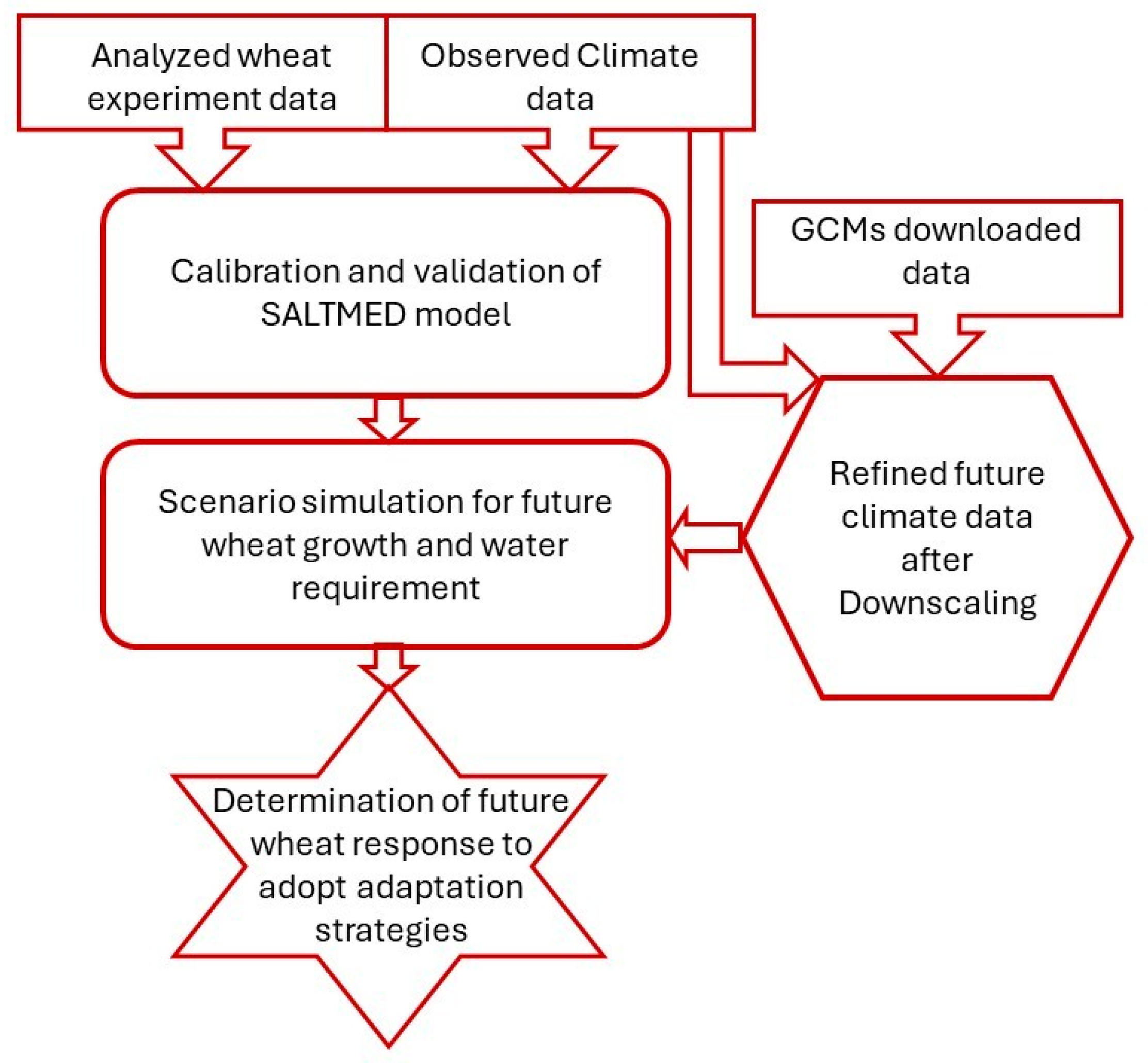

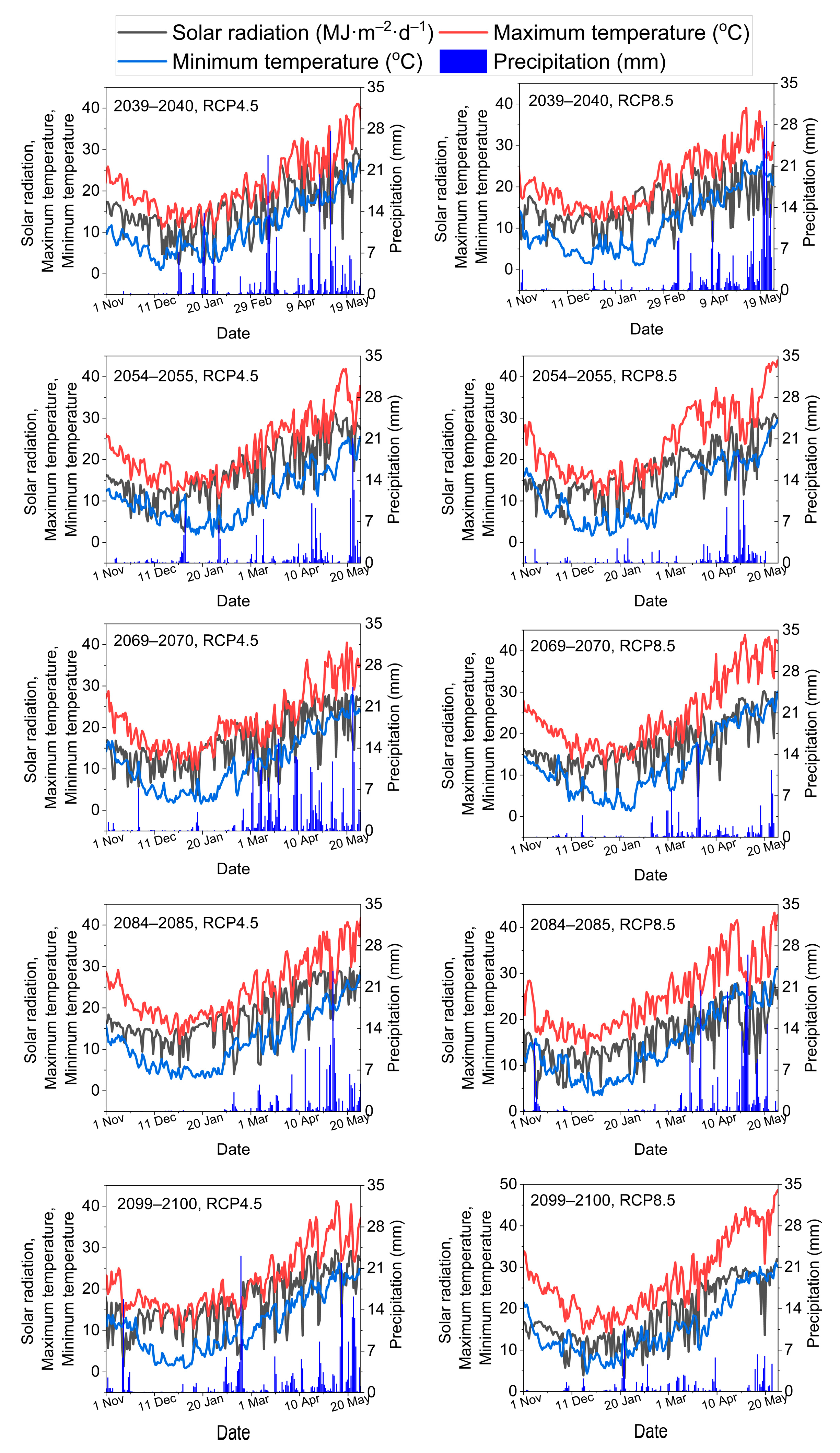
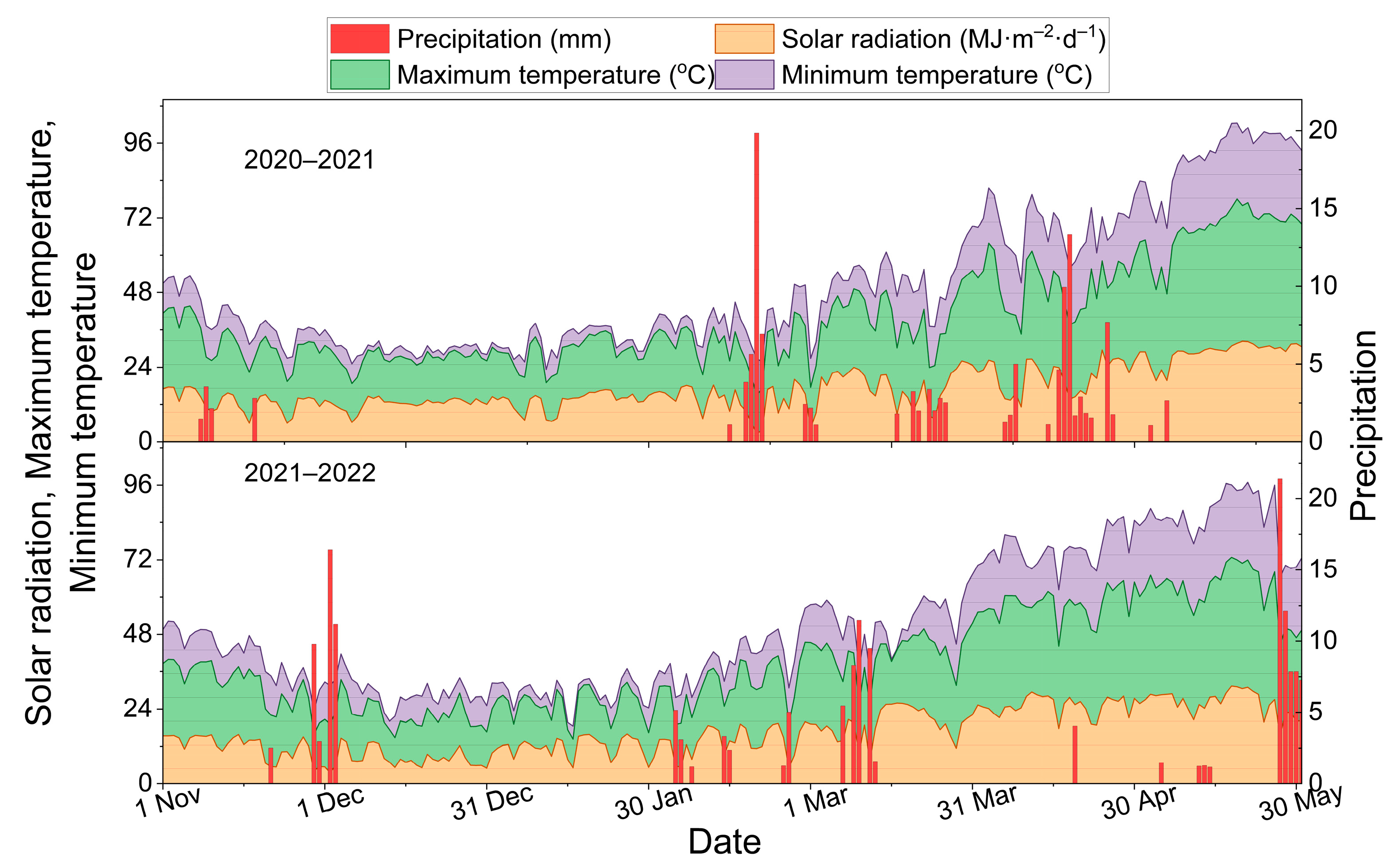
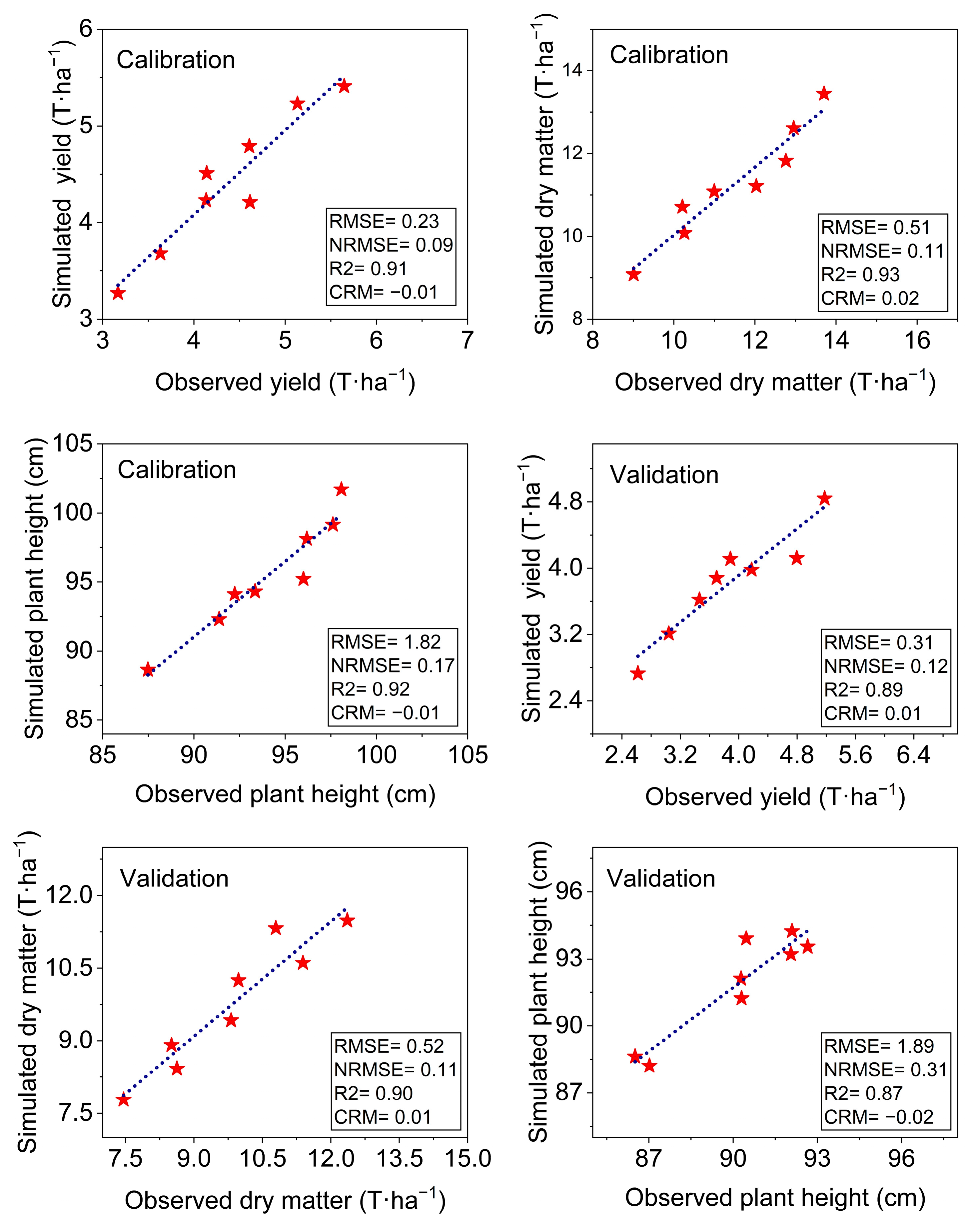

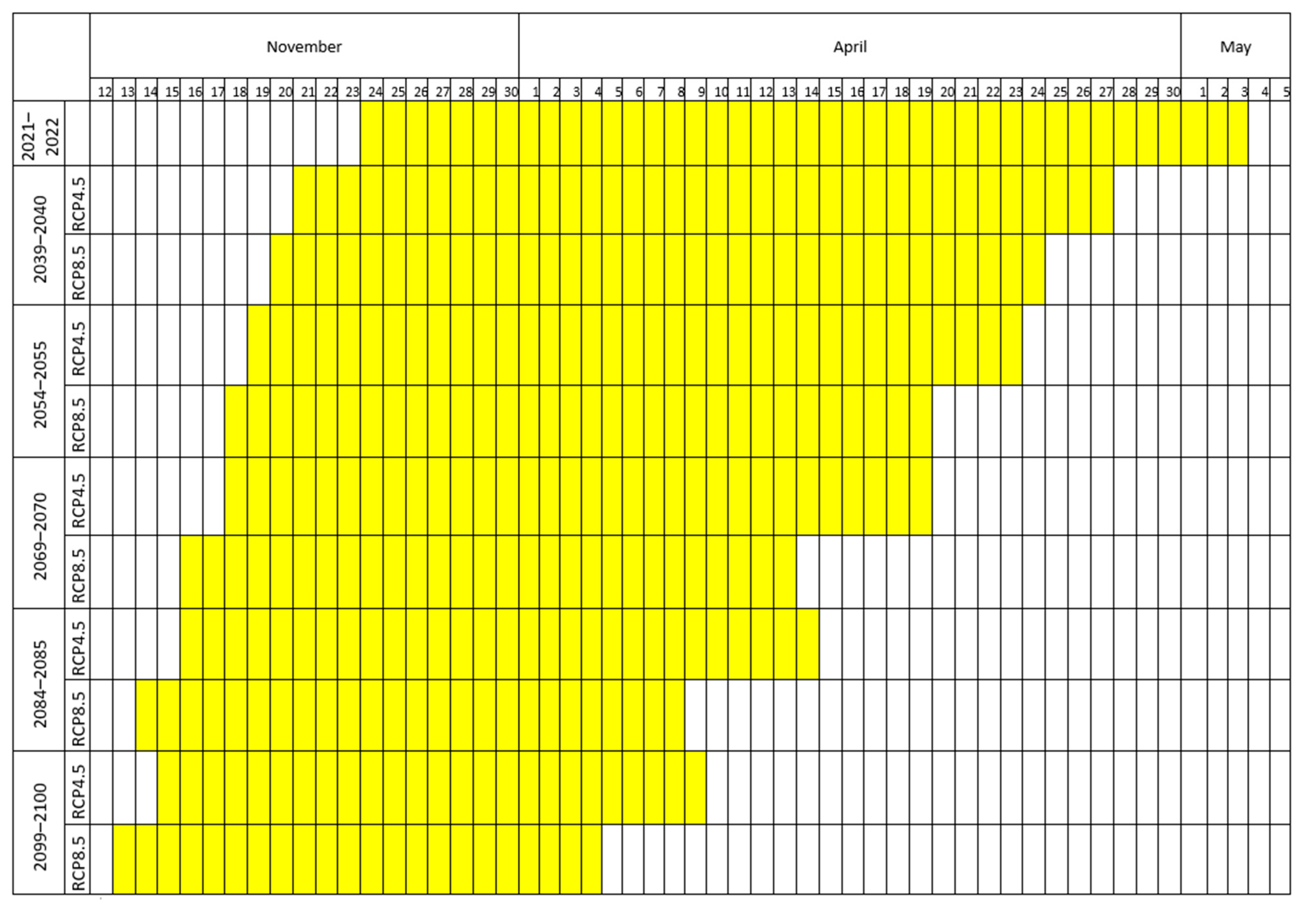
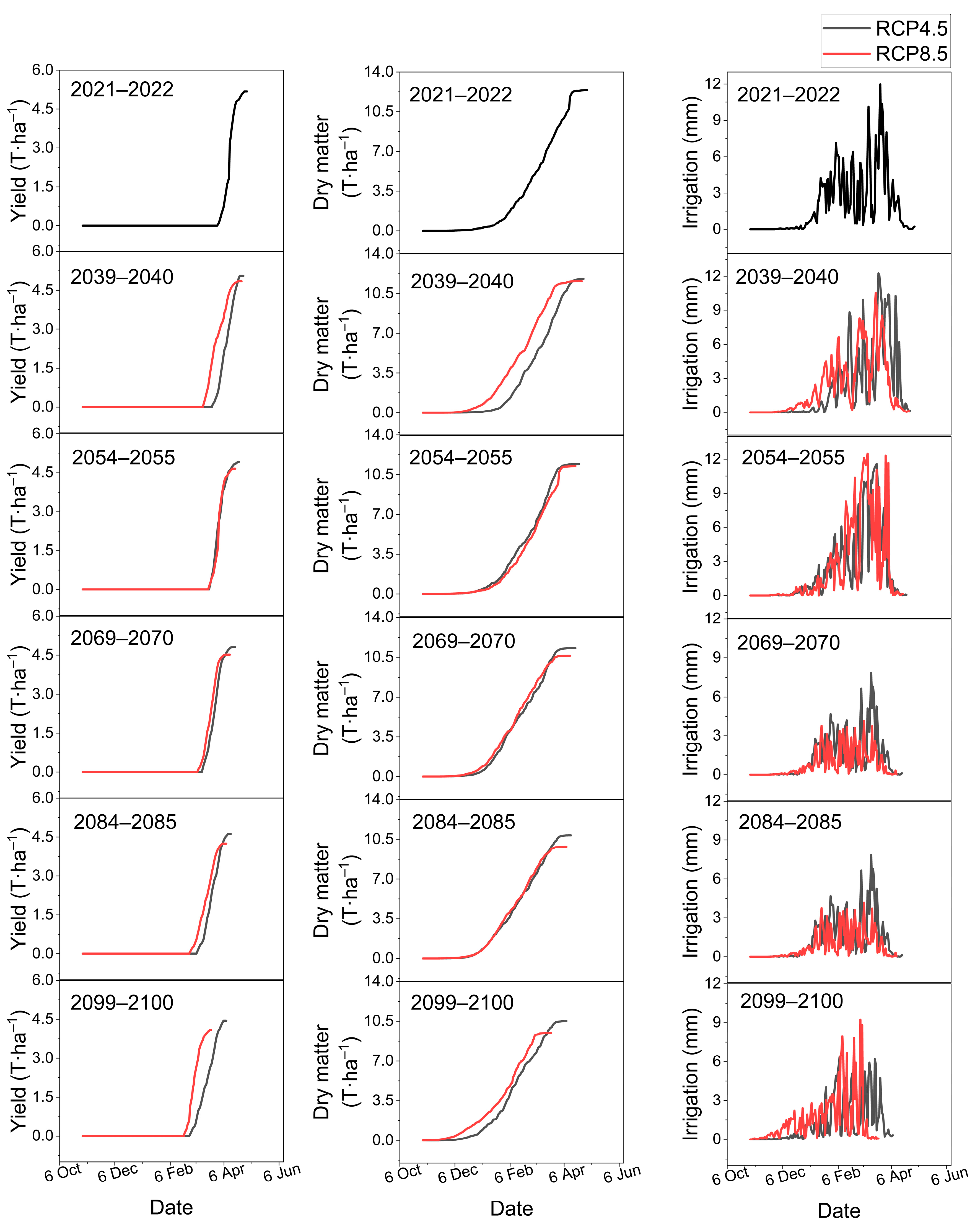
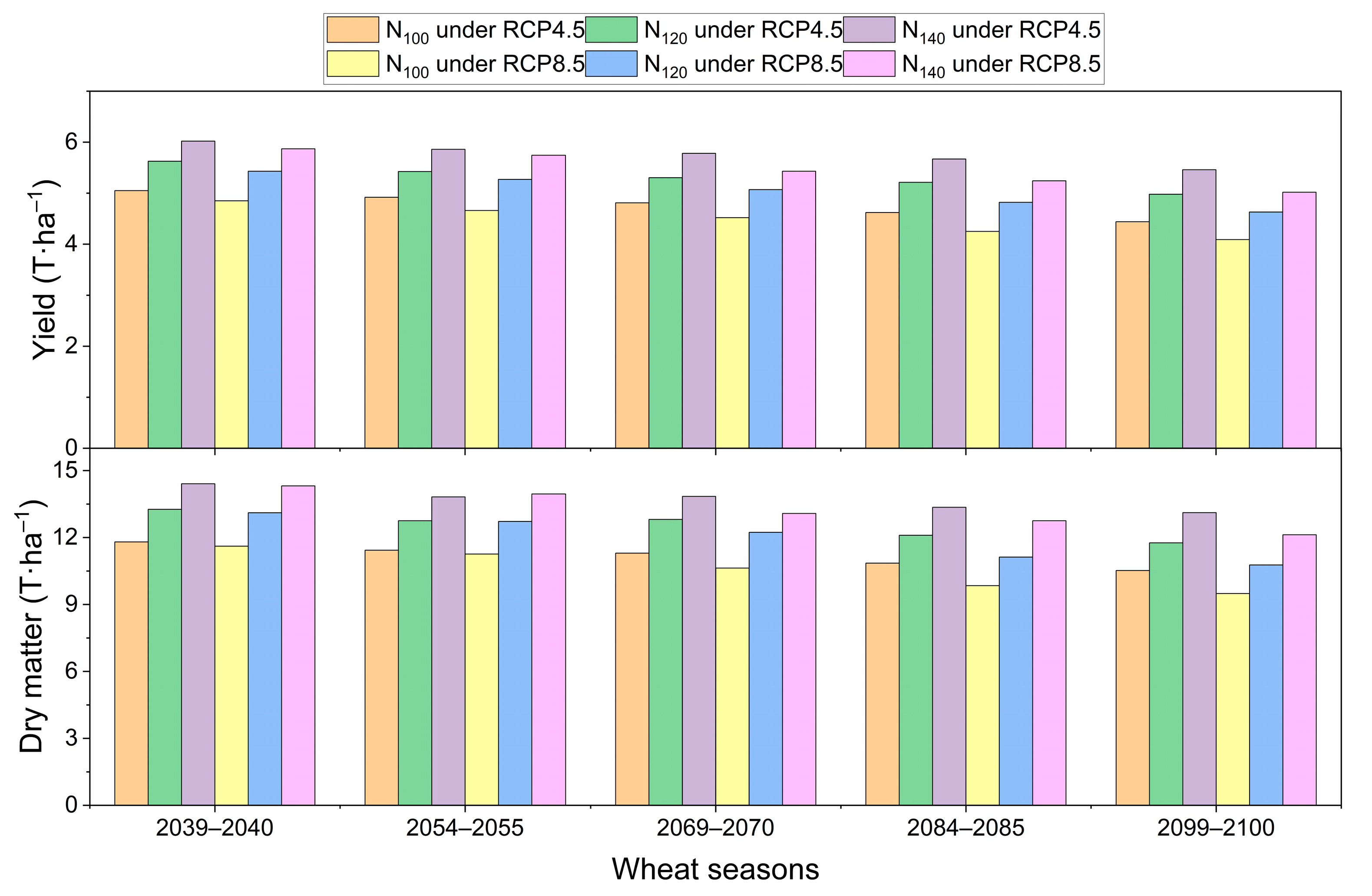
| Parameters | Site-1 | Site-2 | Acceptable Ranges of Selected Parameters [24] |
|---|---|---|---|
| Physical properties | |||
| Soil texture | Sandy clay loam soil (50.14% sand, 23.35% silt, 26.51 clay) | Sandy clay loam soil (47.21% sand, 26.49% silt, 26.3 clay) | ---- |
| Bulk density (g·cm−3) | 1.63 | 1.54 | |
| Chemical properties | |||
| pH | 8.7 | 8.1 | 7–7.5 |
| EC (dS·m−1) | 8.4 | 4.2 | <2 for good soil, 4–8 for moderate soil |
| SAR: sodium adsorption ratio (meq·L−1) | 17 | 10 | 8–18 |
| O.M: organic matter (%) | 1.4 | 4.2 | 3–5 |
| N: nitrogen (mg·kg−1) | 12 | 35 | 20–40 |
| P: Olsen phosphate (mg·kg−1) | 7.0 | 22 | 15–30 |
| K: extractable potassium (mg·kg−1) | 85 | 145 | 100–200 |
| Zn: zinc (mg·kg−1) | 0.2 | 1.2 | 1–3 |
| Fe: iron (mg·kg−1) | 2 | 4.2 | 4.5–6.5 |
| Mn: manganese (mg·kg−1) | 2.1 | 3.2 | 2–5 |
| Cu: copper (mg·kg−1) | 0.15 | 0.27 | 0.2–1.0 |
| Yield (T·ha−1) | Dry Matter (T·ha−1) | Plant Height (cm) | Water Productivity (kg·m−3) | |
|---|---|---|---|---|
| Treatment Wise Comparison | ||||
| I100 × N100 | 4.83 a ± 0.20 | 12.45 a ± 0.33 | 95.11 a ± 1.37 | 1.16 b ± 0.05 |
| I80 × N100 | 4.38 b ± 0.18 | 11.54 b + 0.23 | 93.02 ab ± 0.84 | 1.29 a ± 0.06 |
| I100 × N80 | 3.87 c ± 0.17 | 9.88 c ± 0.28 | 91.99 b ± 0.89 | 0.93 d ± 0.04 |
| I80 × N80 | 3.40 d ± 0.19 | 8.84 d ± 0.31 | 88.31 c ± 0.87 | 1.01 c ± 0.05 |
| LSD | 0.445 | 0.904 | 2.879 | 0.064 |
| Year Wise Comparison | ||||
| 2020–2021 | 4.38 a ± 0.16 | 11.49 a ± 0.32 | 94.04 a ± 0.87 | 1.14 a ± 0.04 |
| 2021–2022 | 3.86 b ± 0.17 | 9.87 b ± 0.32 | 90.17 b ± 0.62 | 1.05 b ± 0.05 |
| LSD | 0.471 | 0.936 | 2.192 | 0.081 |
| Site Wise Comparison | ||||
| Site-1 | 3.57 b ± 0.13 | 10.12 b ± 0.36 | 91.21 a ± 0.77 | 0.95 b ± 0.03 |
| Site-2 | 4.67 a ± 0.14 | 11.24 a ± 0.33 | 93.01 a ± 0.89 | 1.25 a ± 0.04 |
| LSD | 0.368 | 1.001 | 2.425 | 0.092 |
| Soil Parameters | Crop Parameters | ||
|---|---|---|---|
| Parameters | Calibrated/Measured Value | Parameters | Calibrated/Measured Value |
| Saturated water content/porosity | 0.442 m3·m−3 | Harvest index | 0.432 |
| Maximum evaporation depth | 96 mm | Leaf area index | 0.86 (initial stage) 0.47 (mid stage) 0.45 (end stage) |
| Wilting point | 0.121 m3·m−3 | Fraction cover (Fc) | 0.56 (initial stage) 0.92 (mid stage) 0.97 (end stage) |
| Field capacity | 0.212 m3·m−3 | Transpiration crop coefficient (Kcb) | 0.58 (initial stage) 0.91 (mid stage) 0.47 (end stage) |
| Bubbling pressure | 9.29 cm | Plant height | 0.35 m (initial stage) 1.05 m (mid stage) 1.00 m (end stage) |
| Saturated hydraulic conductivity | 128 mm·d−1 | π50 | 10 (initial stage) 11 (mid stage) 13 (end stage) |
| Lambda pore size distribution index | 0.310 | Crop coefficient (Kc) | 0.7 (initial stage) 1.21 (mid stage) 0.48 (end stage) |
| Model Run | Sites | Treatment | Yield (T·ha−1) | Dry Matter (T·ha−1) | Plant Height (cm) | |||
|---|---|---|---|---|---|---|---|---|
| Observed | Simulated | Observed | Simulated | Observed | Simulated | |||
| Calibration | Site-1 | I100 × N100 | 4.61 | 4.79 | 12.95 | 12.61 | 98.08 | 101.70 |
| I100 × N100 | 5.65 | 5.41 | 13.70 | 13.44 | 97.62 | 99.14 | ||
| I80 × N100 | 4.14 | 4.51 | 12.03 | 11.21 | 93.35 | 94.32 | ||
| I80 × N100 | 5.14 | 5.23 | 12.76 | 11.82 | 96.19 | 98.12 | ||
| Site-2 | I100 × N80 | 3.63 | 3.68 | 10.21 | 10.71 | 91.38 | 92.31 | |
| I100 × N80 | 4.61 | 4.21 | 11.00 | 11.08 | 96.00 | 95.21 | ||
| I80 × N80 | 3.17 | 3.27 | 9.01 | 9.08 | 87.48 | 88.64 | ||
| I80 × N80 | 4.13 | 4.23 | 10.26 | 10.08 | 92.24 | 94.12 | ||
| RMSE | 0.23 | -- | 0.51 | -- | 1.82 | -- | ||
| NRMSE | 0.09 | -- | 0.11 | -- | 0.17 | -- | ||
| R2 | 0.91 | -- | 0.93 | -- | 0.92 | -- | ||
| CRM | -0.01 | -- | 0.02 | -- | -0.01 | -- | ||
| Validation | Site-1 | I100 × N100 | 3.89 | 4.11 | 10.80 | 11.32 | 92.1 | 94.2 |
| I100 × N100 | 5.18 | 4.84 | 12.36 | 11.48 | 92.7 | 93.5 | ||
| I80 × N100 | 3.46 | 3.62 | 9.98 | 10.25 | 90.5 | 93.9 | ||
| I80 × N100 | 4.80 | 4.12 | 11.39 | 10.61 | 92.1 | 93.2 | ||
| Site-2 | I100 × N80 | 3.04 | 3.21 | 8.51 | 8.91 | 90.28 | 92.12 | |
| I100 × N80 | 4.18 | 3.98 | 9.81 | 9.42 | 90.30 | 91.23 | ||
| I80 × N80 | 2.62 | 2.73 | 7.46 | 7.78 | 86.51 | 88.62 | ||
| I80 × N80 | 3.70 | 3.88 | 8.63 | 8.42 | 87.02 | 88.21 | ||
| RMSE | 0.31 | -- | 0.52 | -- | 1.89 | -- | ||
| NRMSE | 0.12 | -- | 0.11 | -- | 0.31 | -- | ||
| R2 | 0.89 | -- | 0.90 | -- | 0.87 | -- | ||
| CRM | 0.01 | -- | 0.01 | -- | −0.02 | -- | ||
| Wheat Season | Wheat Yield (T·ha−1) | Dry Matter (T·ha−1) | |||||||
| Baseline data | 2021–2022 | 5.18 | 12.36 | ||||||
| RCP4.5 | % Decrease | RCP8.5 | % Decrease | RCP4.5 | % Decrease | RCP8.5 | % Decrease | ||
| Future simulations | 2039–2040 | 5.05 | 2.4 | 4.85 | 6.3 | 11.80 | 4.6 | 11.61 | 6.1 |
| 2054–2055 | 4.92 | 5.1 | 4.66 | 10.0 | 11.43 | 7.5 | 11.26 | 8.9 | |
| 2069–2070 | 4.81 | 7.1 | 4.52 | 12.8 | 11.30 | 8.6 | 10.63 | 14.0 | |
| 2084–2085 | 4.62 | 10.9 | 4.25 | 18.0 | 10.85 | 12.2 | 9.84 | 20.4 | |
| 2099–2100 | 4.44 | 14.2 | 4.09 | 21.0 | 10.52 | 14.9 | 9.49 | 23.3 | |
| Wheat season | Irrigation requirement (mm) | Water productivity (kg·m−3) | |||||||
| Baseline data | 2021–2022 | 365 | 1.42 | ||||||
| RCP4.5 | % Increase | RCP8.5 | % Increase | RCP4.5 | % Decrease | RCP8.5 | % Decrease | ||
| Future simulations | 2039–2040 | 376 | 3.0 | 385 | 5.5 | 1.34 | 5.3 | 1.26 | 11.2 |
| 2054–2055 | 383 | 5.0 | 391 | 7.0 | 1.28 | 9.6 | 1.19 | 15.9 | |
| 2069–2070 | 395 | 8.1 | 405 | 11.1 | 1.22 | 14.1 | 1.11 | 21.5 | |
| 2084–2085 | 406 | 11.2 | 417 | 14.2 | 1.14 | 19.9 | 1.02 | 28.2 | |
| 2099–2100 | 419 | 14.9 | 431 | 18.0 | 1.06 | 25.3 | 0.95 | 33.0 | |
| Wheat Season | % Increase in Yield under RCP4.5 | % Increase in Yield under RCP4.5 | ||
| N120 | N140 | N120 | N140 | |
| 2039–2040 | 11.4 | 19.2 | 12.0 | 21.0 |
| 2054–2055 | 10.2 | 19.1 | 13.1 | 23.2 |
| 2069–2070 | 10.2 | 20.2 | 12.2 | 20.1 |
| 2084–2085 | 12.8 | 22.7 | 13.4 | 23.4 |
| 2099–2100 | 12.1 | 23.0 | 13.2 | 22.7 |
| Average | 11.4 | 20.8 | 12.8 | 22.1 |
| % increase in dry matter under RCP4.5 | % increase in dry matter under RCP8.5 | |||
| N120 | N140 | N120 | N140 | |
| 2039–2040 | 12.4 | 22.1 | 12.9 | 23.3 |
| 2054–2055 | 11.5 | 20.9 | 13.0 | 23.9 |
| 2069–2070 | 13.4 | 22.5 | 15.1 | 23.0 |
| 2084–2085 | 11.5 | 23.1 | 13.0 | 29.6 |
| 2099–2100 | 11.8 | 24.6 | 13.5 | 27.7 |
| Average | 12.1 | 22.6 | 13.5 | 25.5 |
Disclaimer/Publisher’s Note: The statements, opinions and data contained in all publications are solely those of the individual author(s) and contributor(s) and not of MDPI and/or the editor(s). MDPI and/or the editor(s) disclaim responsibility for any injury to people or property resulting from any ideas, methods, instructions or products referred to in the content. |
© 2024 by the authors. Licensee MDPI, Basel, Switzerland. This article is an open access article distributed under the terms and conditions of the Creative Commons Attribution (CC BY) license (https://creativecommons.org/licenses/by/4.0/).
Share and Cite
Chauhdary, J.N.; Li, H.; Ragab, R.; Rakibuzzaman, M.; Khan, A.I.; Zhao, J.; Akbar, N. Climate Change Impacts on Future Wheat (Triticum aestivum) Yield, Growth Periods and Irrigation Requirements: A SALTMED Model Simulations Analysis. Agronomy 2024, 14, 1484. https://doi.org/10.3390/agronomy14071484
Chauhdary JN, Li H, Ragab R, Rakibuzzaman M, Khan AI, Zhao J, Akbar N. Climate Change Impacts on Future Wheat (Triticum aestivum) Yield, Growth Periods and Irrigation Requirements: A SALTMED Model Simulations Analysis. Agronomy. 2024; 14(7):1484. https://doi.org/10.3390/agronomy14071484
Chicago/Turabian StyleChauhdary, Junaid Nawaz, Hong Li, Ragab Ragab, Md Rakibuzzaman, Azeem Iqbal Khan, Jing Zhao, and Nadeem Akbar. 2024. "Climate Change Impacts on Future Wheat (Triticum aestivum) Yield, Growth Periods and Irrigation Requirements: A SALTMED Model Simulations Analysis" Agronomy 14, no. 7: 1484. https://doi.org/10.3390/agronomy14071484








